When Teal brought me in, their bottom-of-funnel content was barely moving the needle. Blog posts weren’t driving demos, and there was no clear understanding of how published content impacted conversion.
The main issue I noticed was a disconnect between teams holding critical information, making it difficult to create a repeatable system for conversion.
In 90 days, we built an AI BoFu workflow that aligned content with customer pain and product value, lifting conversions from 6.94% to 30%.
In this article, I’ll walk you through the framework for building your own BoFu strategy and driving more conversions with AI.
But first, I need to state two important things…
You can’t create BoFu content with siloed communication
Most teams fail at BoFu (bottom of the funnel) content because the people who hold the insights aren’t in the same room.
- Sales knows the objections
- Customer success hears the recurring pain points
- Product understands the features that actually solve them
But none of that makes it into the brief.
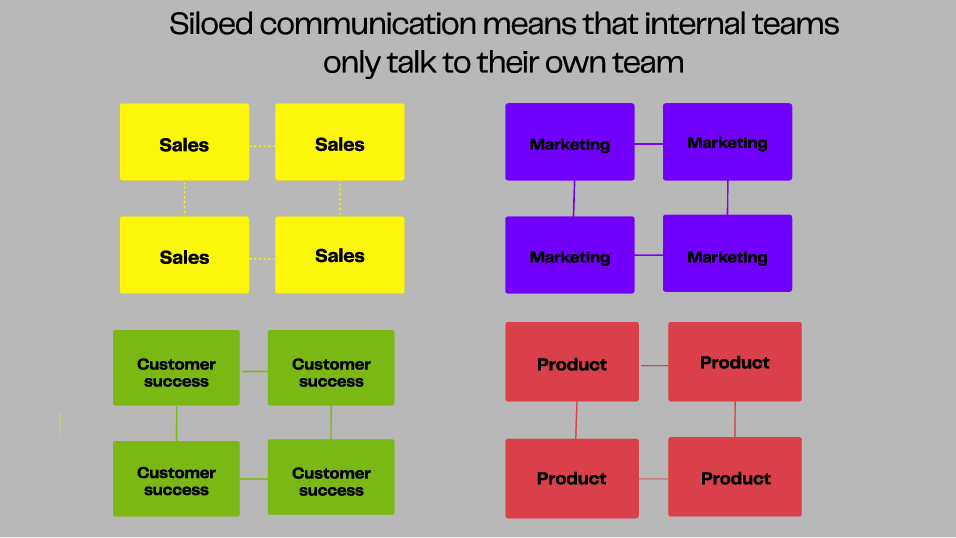
Siloed communication breaks the feedback loop that BoFu content depends on. The result is content that looks bland and doesn’t drive conversions.
I call this the BoFu gap, where the content for the ToFu (top of the funnel) and MoFu (middle of the funnel) is well-developed, but the BoFu strategy is misaligned.
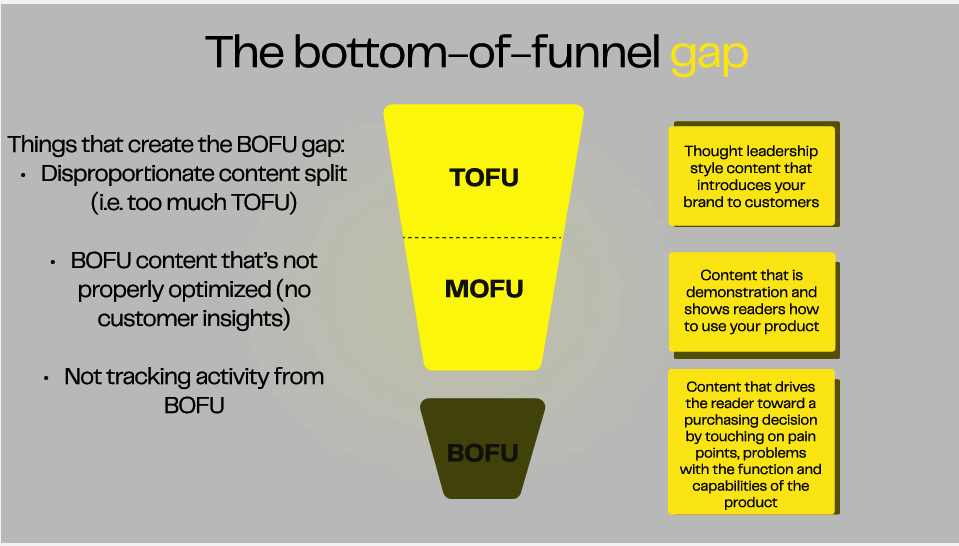
There’s a disconnect between what buyers need to hear at the decision stage and what actually gets published.
Closing that gap starts with cross-functional input that doesn’t happen with a keyboard.
Good BoFu content bridges the gap between marketing and sales
High-performing BoFu content doesn’t sit in isolation. It pulls directly from sales conversations and questions prospects ask before buying, and turns that into assets for the entire funnel.

Case studies, comparison pages, and other enablement assets all serve a dual purpose of attracting qualified leads and supporting the buying conversation.
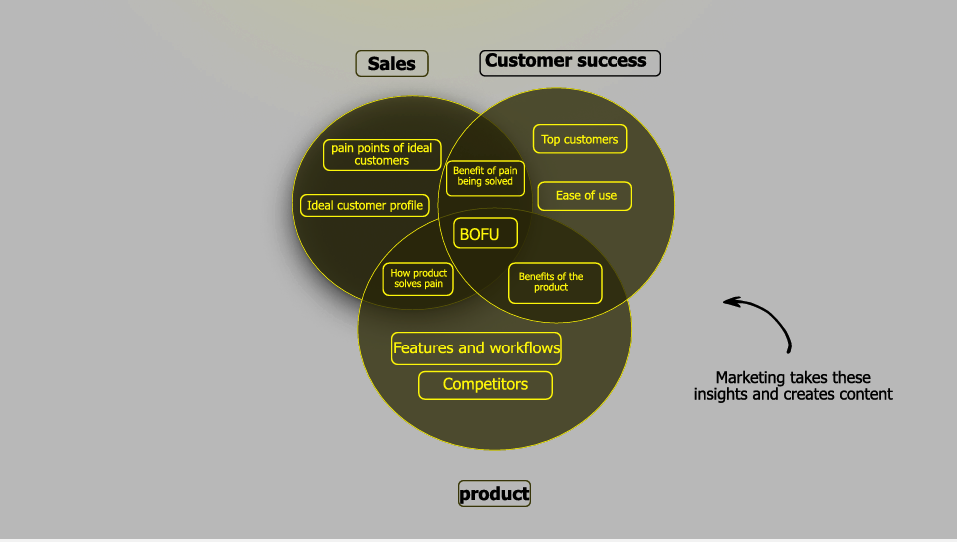
This alignment is where BoFu content transforms from driving traffic into a collateral that moves leads through the pipeline.
Now that I’ve got that out of the way, here’s how to automate your BoFu strategy with AI.
1. Do customer and product research to find BoFu opportunities
Most AI BoFu content miss the mark because it pulls from the open web. The data is too generic to influence high-stakes buying decisions.

The best BoFu content is grounded in customer language and product expertise, insights that live inside your company, not outside.
Here’s how to get the insights through customer and product research:
Build a custom research assistant
I built my BoFu research assistant with a few tools listed below:
- Perplexity
- Gemini
- Open AI
- Make
However, for this article, we’ll be using OpenAI’s ChatGPT.
Start by creating a simple GPT research assistant to organize internal knowledge.
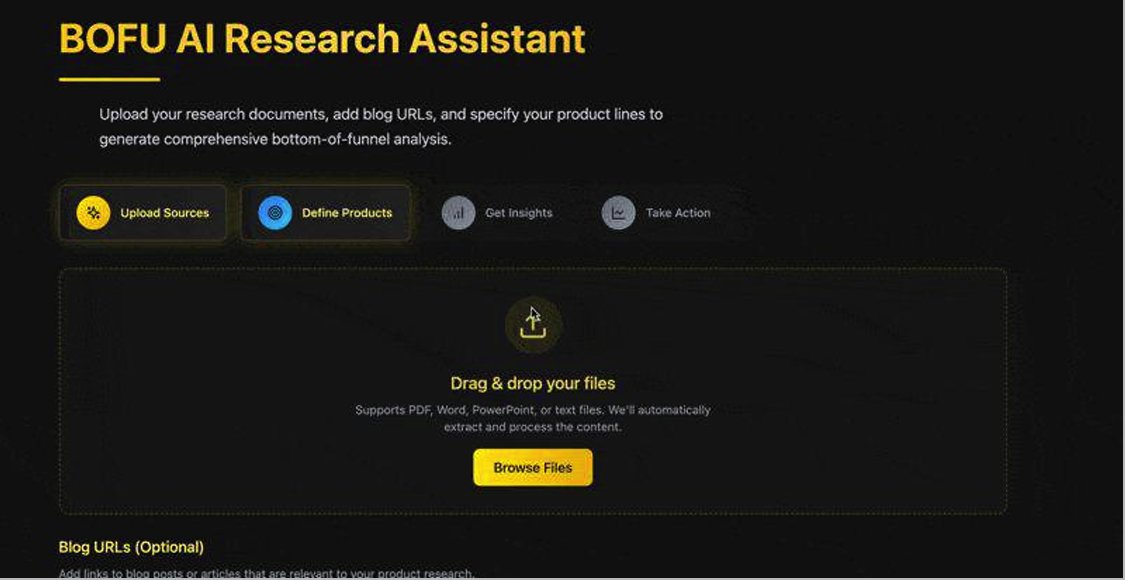
Feed it sales call transcripts, customer support notes, product documentation, and messaging guides. These documents contain pain points, objections, and benefits that prospects voice before making a purchase.
With a custom assistant, you can centralize all of this into themes:
- Pain points that drive urgency
- Objections that stall decisions
- Product capabilities that solve them
- Benefits customers highlight post-sale
Here’s how to set it up:
Open ChatGPT and go to My GPTs. Next, click Create a GPT and write custom instructions that define its role. Here’s the custom instruction I wrote for mine.
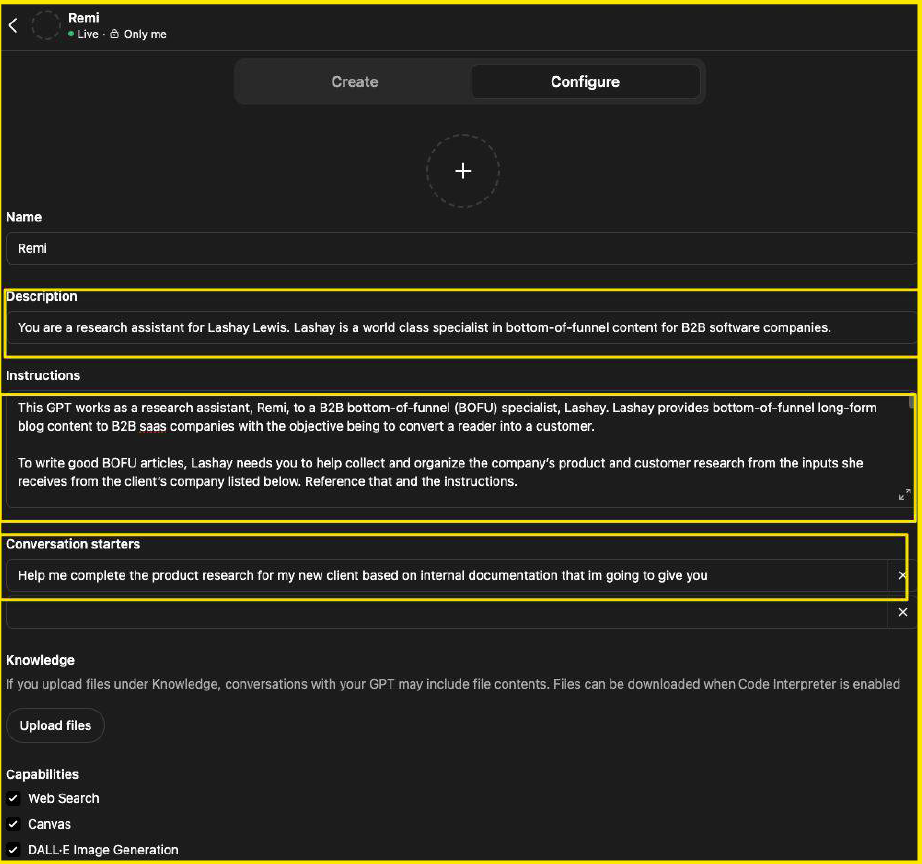
Upload your files to a shared folder (Google Drive works well) and connect it to the GPT. Then, feed the GPT examples so it learns the right output format.
The output should look like this:
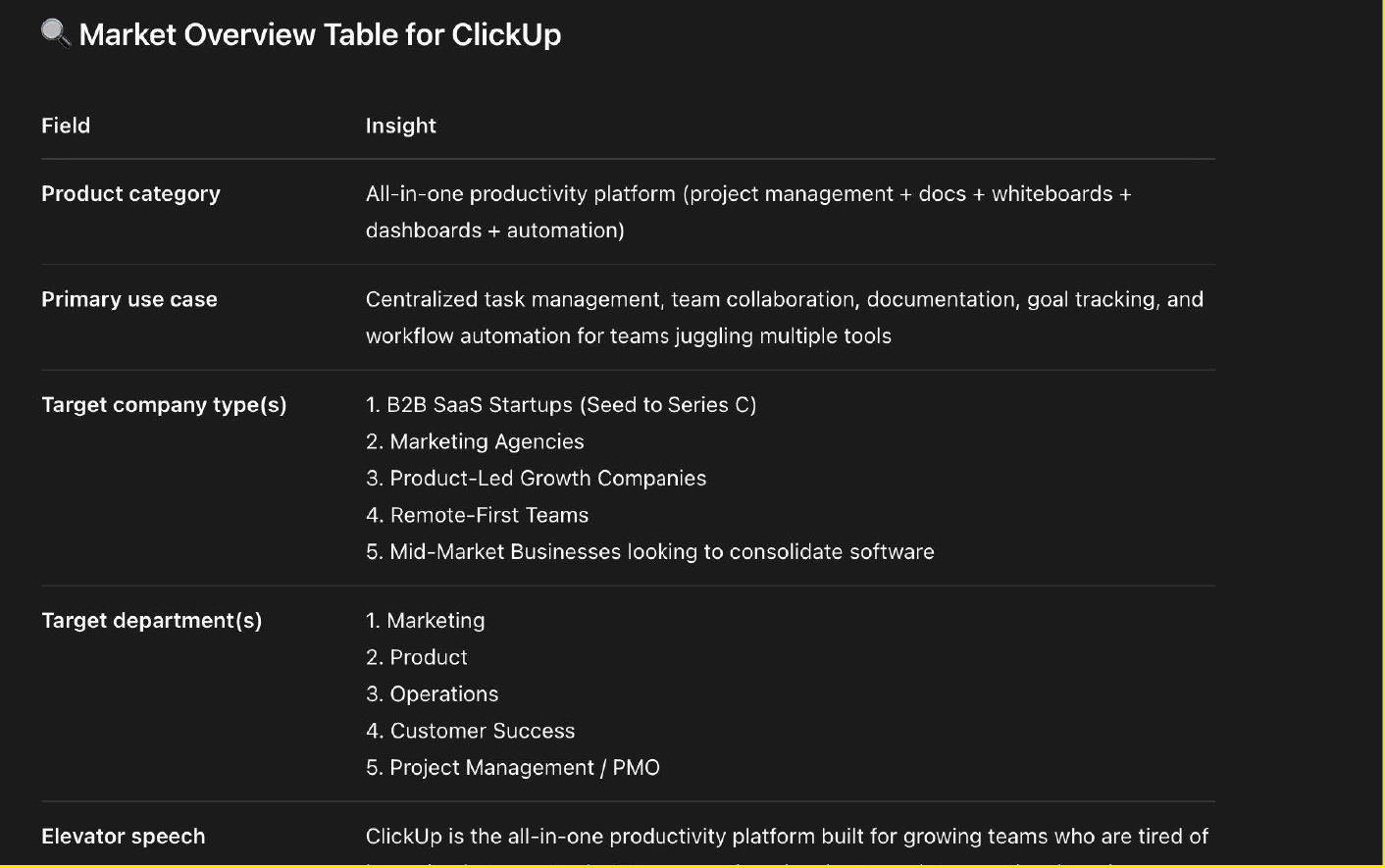
This becomes the foundation for every BoFu article. Instead of guessing what matters at the decision stage, you’re starting with information your teams already know.
2. Do competitor research to find conversion opportunities
I urge you not to cast a wide net when doing competitor research for BoFu content. Similar to what Peter Richman said, you’ll have better success choosing battles you can win.
I use three approaches to do this:
- Keyword gap analysis in Moz
- The Competitor Puzzle framework
- AI-assisted product comparisons
Run keyword gap analysis with tools like Moz
The first step is to use a competitor analysis tool like Moz to conduct a keyword gap analysis.
Enter your URL and add three competitor URLs. Choose your market (US, UK, etc.) and click Analyze competitors.
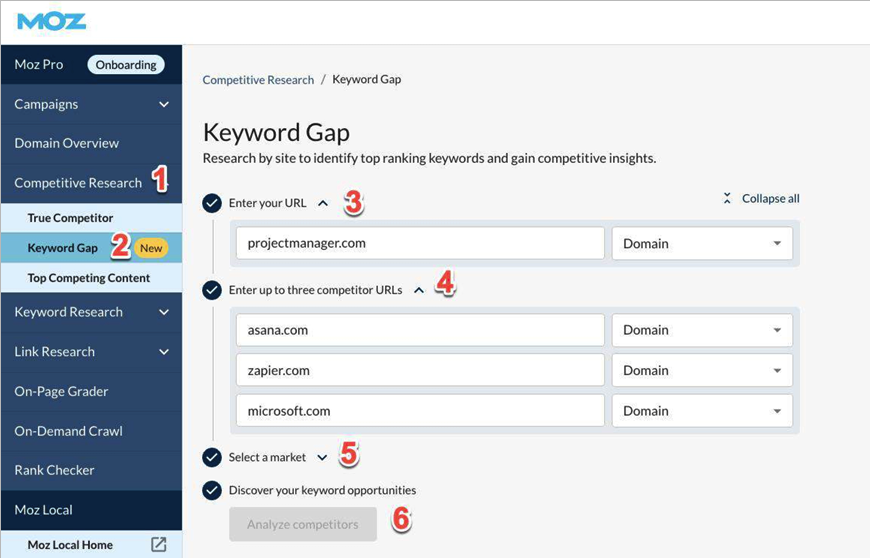
Focus on competitors with overlapping use cases, not massive players with unrelated markets. For example, Zapier makes more sense than Microsoft because the feature set is closer.
The first thing you’ll see is an overview of your keyword performance alongside competitors, which is great for benchmarking.
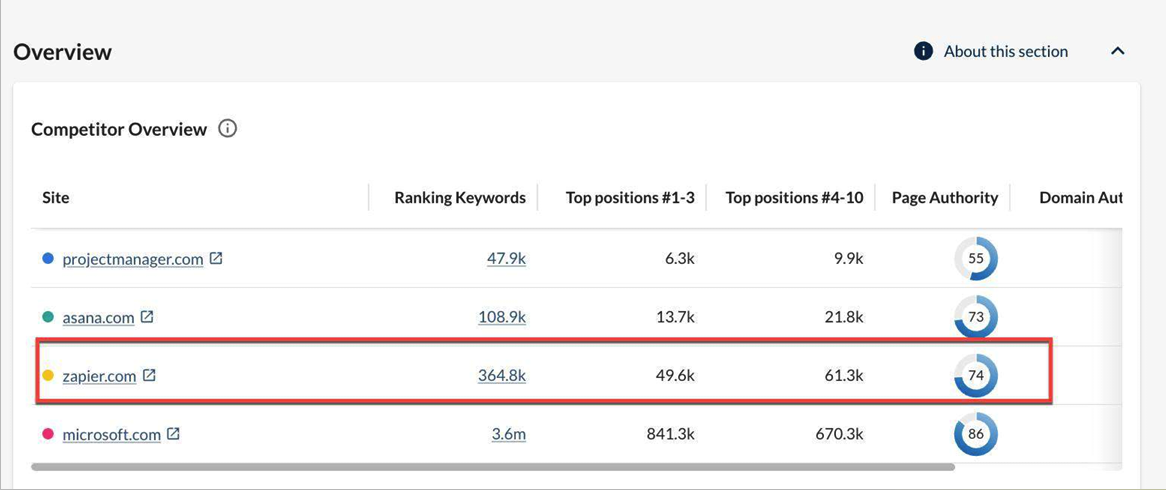
Scroll down and filter results by topic so you’re only looking at relevant keywords.
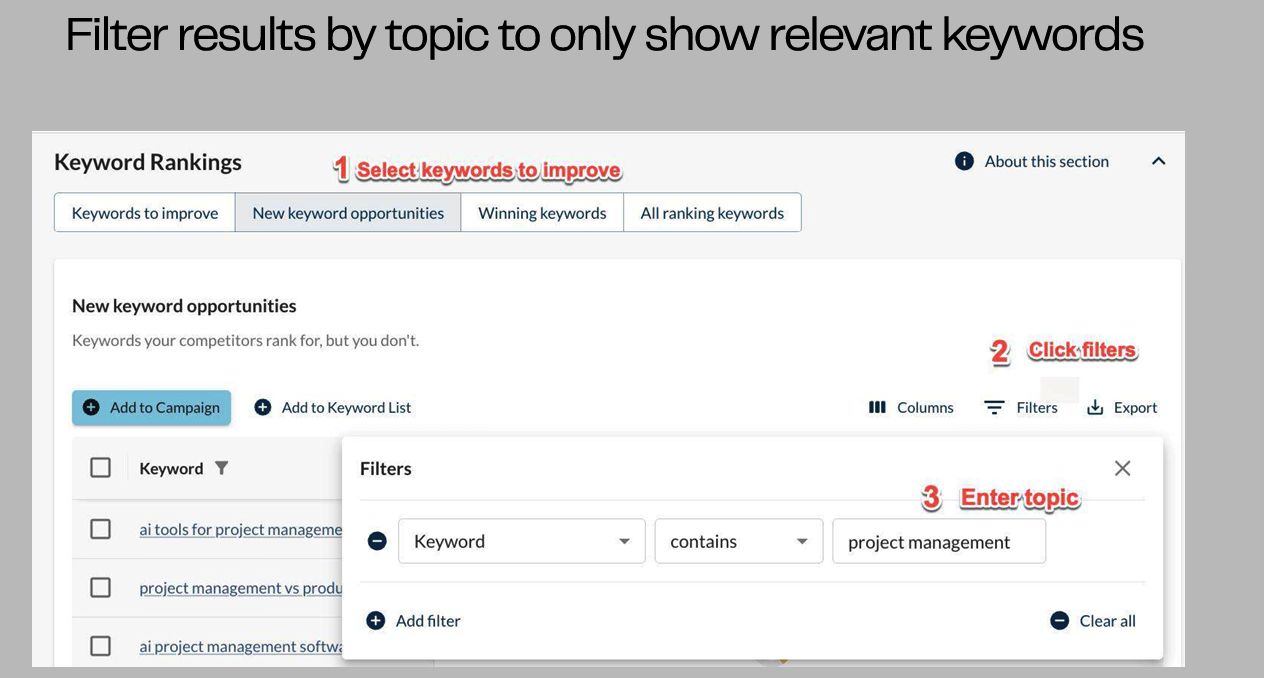
Export the final list into a spreadsheet so you can prioritize terms tied to high-value use cases.
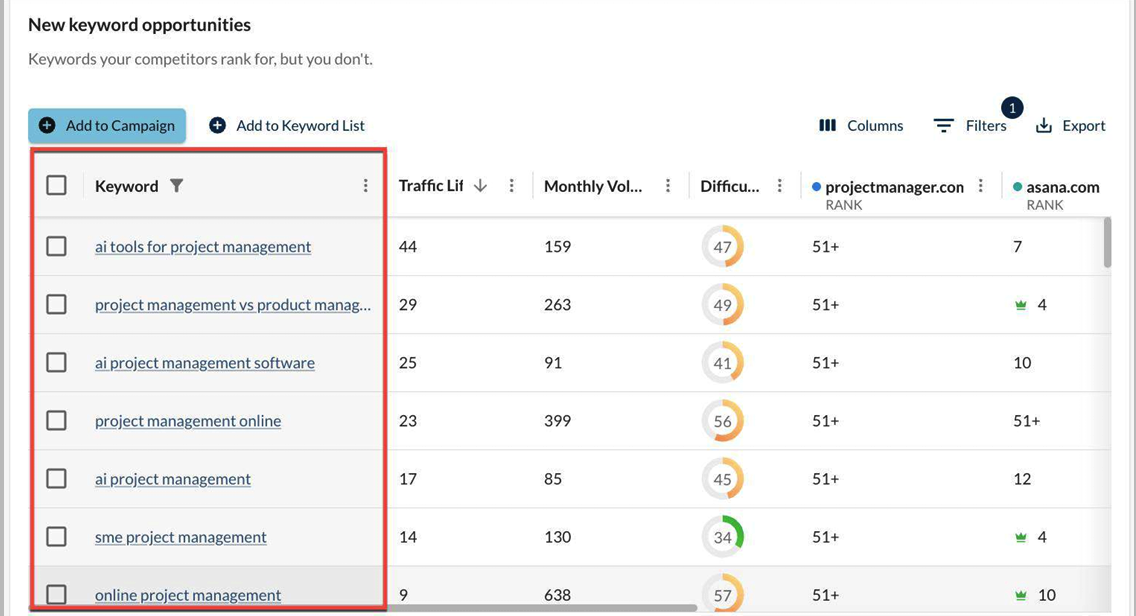
This gives you the short list of opportunities where a BoFu article can compete feature for feature.
Use the Competitor Puzzle framework to categorize competitors
Once you know your keywords, break competitors into three categories:

- Direct competitors: These are companies with a similar offering and feature set. They are your best BoFu targets because prospects are already comparing you head-to-head. For example, Framer, Editor X, or Semplice.
- Niche competitors: These are in the same category but offer fewer features and use cases. You can highlight where you cover more ground and position your product as the more complete solution. For example, Carrd vs. Dorik or Typeream.
- Broad competitors: These operate in the same category but with a much larger feature set, serving a bigger portion of the market. Examples include Shopify, Wix, or Squarespace. Avoid these uphill battles, as they’re rarely worth the effort.
Start with direct and niche competitors, where you can win, and use broad competitors for context or product strategy.
Use AI to generate detailed product comparisons
AI can speed up competitor research and make it easier to structure. The visual below is similar to the competitive puzzle, but automated with AI.
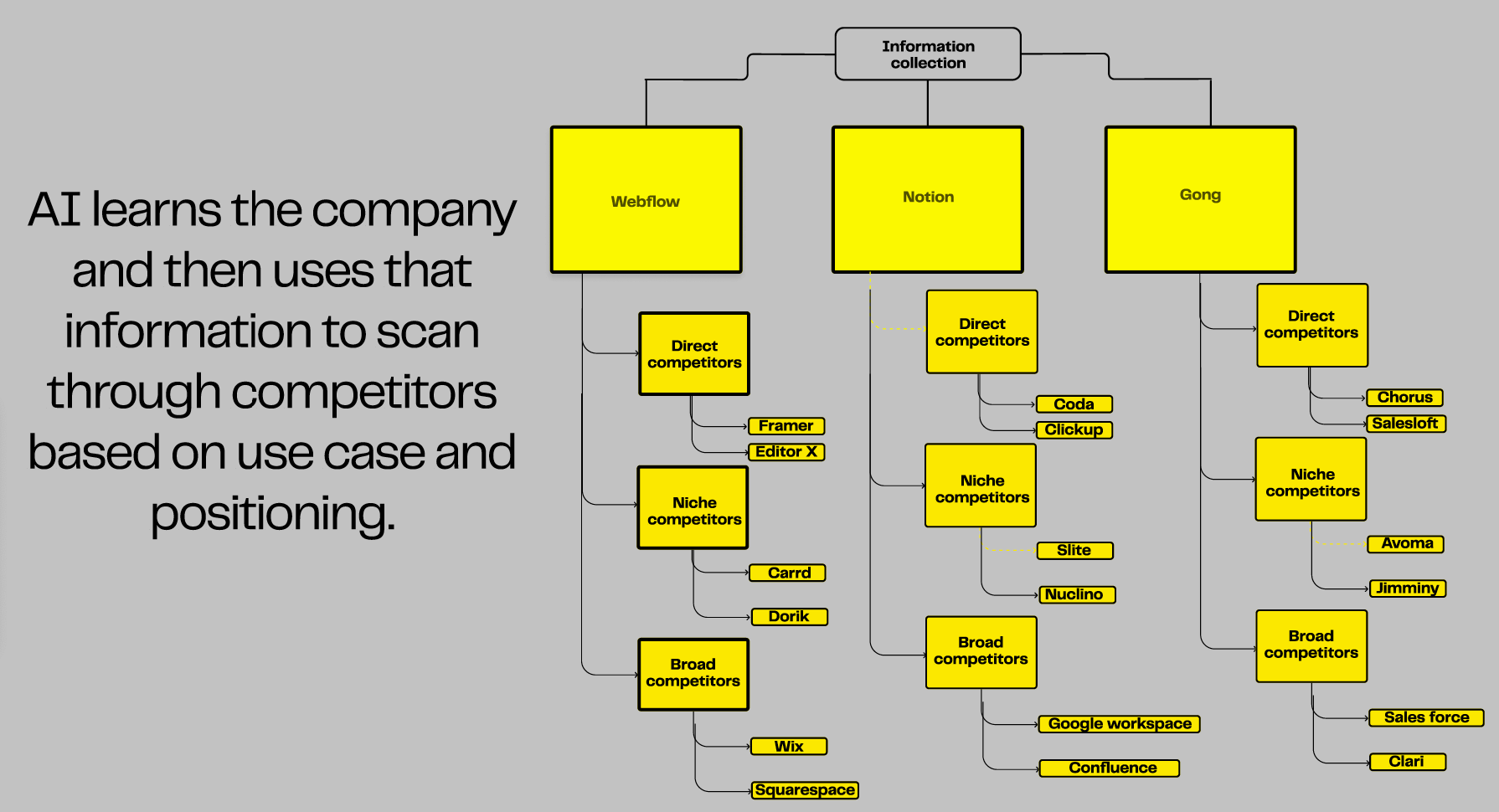
The LLM learns everything it can about your brand. Then, it uses the information you’ve fed it to pull competitors and breaks it down into direct, niche, and broad.
I use Perplexity because it runs multiple searches and organizes results into sources.
The key is writing prompts with three parts:
Role: Define the AI’s perspective.

For example: “You are an elite competitive intelligence analyst with 15 years of experience in product research and market analysis.”
Task: Spell out the job.
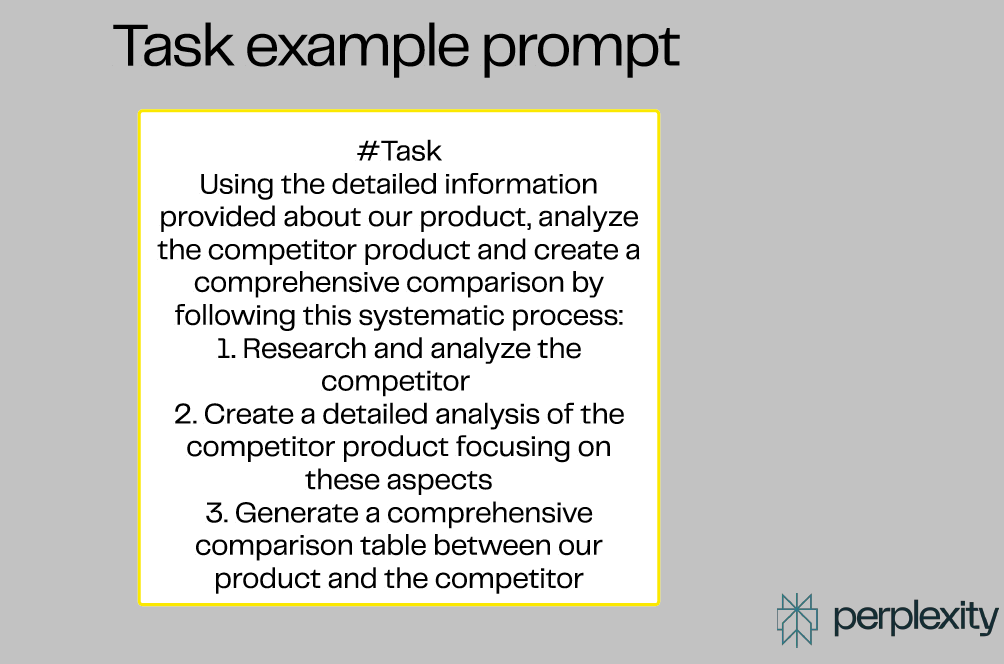
For example: “Using the detailed information provided about our product, analyze the competitor product and create a comprehensive comparison.”
Specifics: Add constraints.
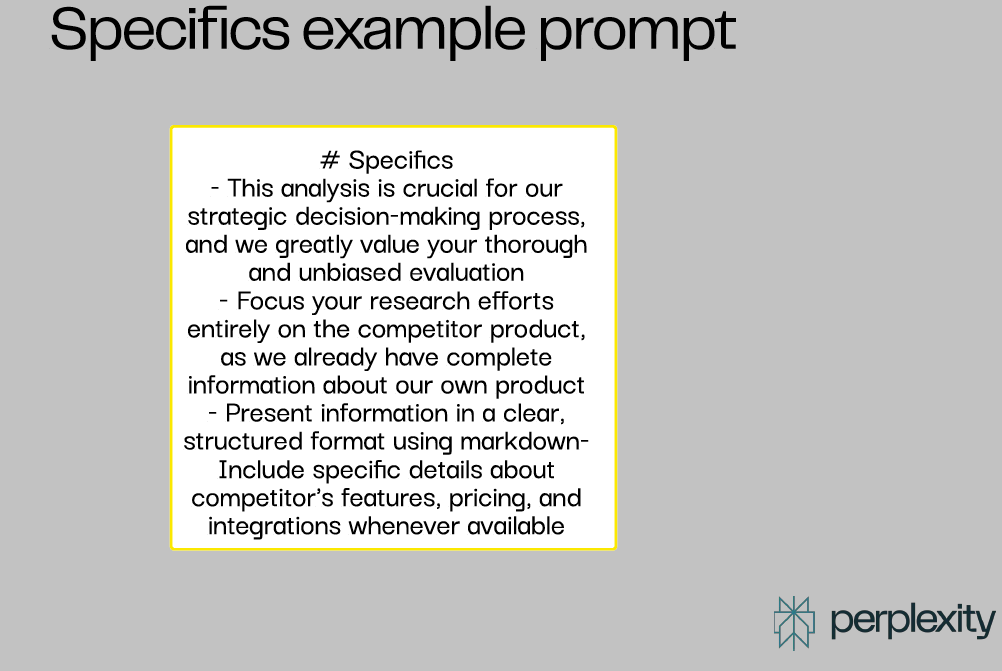
For example: “Focus your research entirely on the competitor’s product. Present information in a clear, structured format using markdown.”
This strategy ensures thorough and consistent output. Instead of a vague summary, you get structured insights you can feed directly into a comparison blog or integration page.
3. Do keyword research for BoFu keywords
The goal of BoFu keyword research is to capture decision-stage queries where buyers are already comparing solutions.
Start with category keywords
Category searches are the foundation of BoFu. For example, project management software.
In Moz’s Keyword Suggestions tool, type your category keyword, and the first thing you’ll see is a Topics Tree Map showing an overview of keywords you can target.
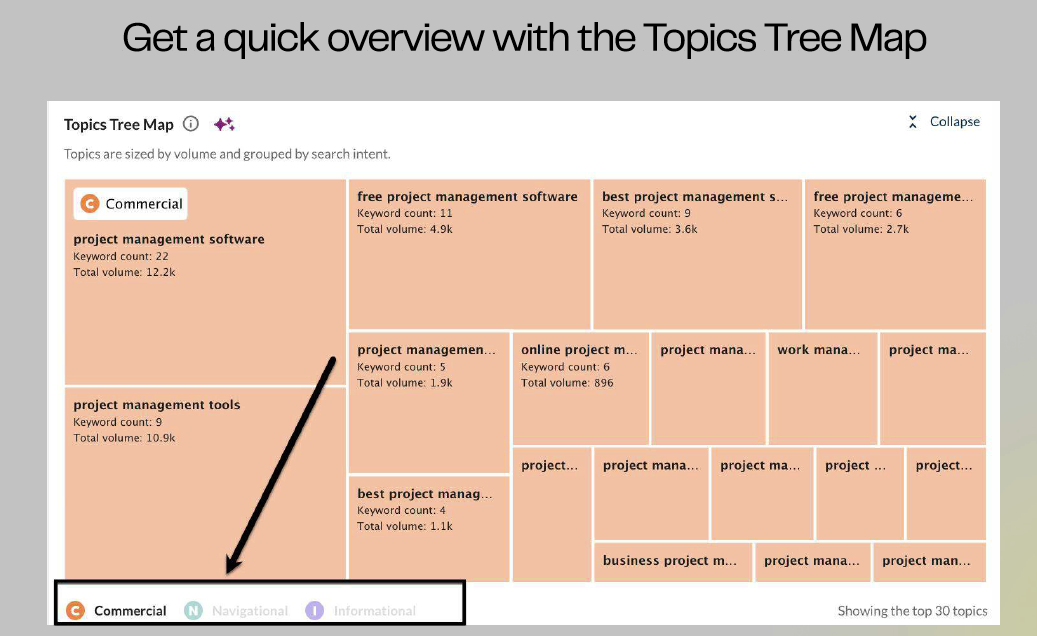
Keywords are grouped by volume and intent, with commercial and transactional terms highlighted. Filtering for commercial intent surfaces the most valuable decision-stage queries.
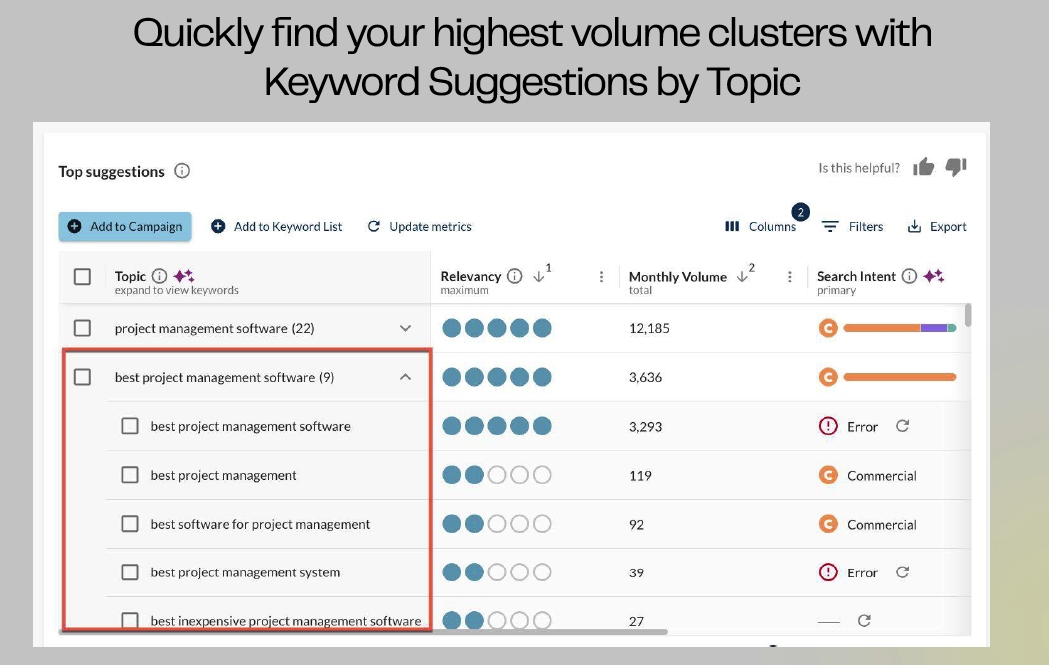
If you scroll down the results page, you’ll see a broader list of keywords grouped into topic clusters that reveal related use cases.
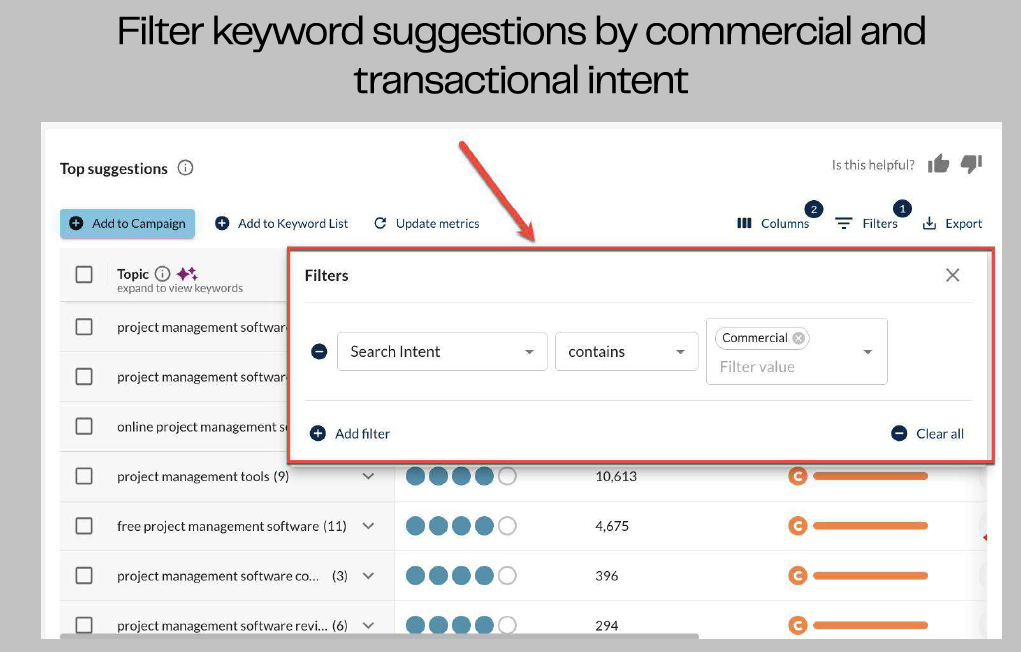
You can get more granular by using the filtering option to see commercial and transactional keywords to target.
Pull insights from each team
Each team inside your company holds data that informs keyword research:
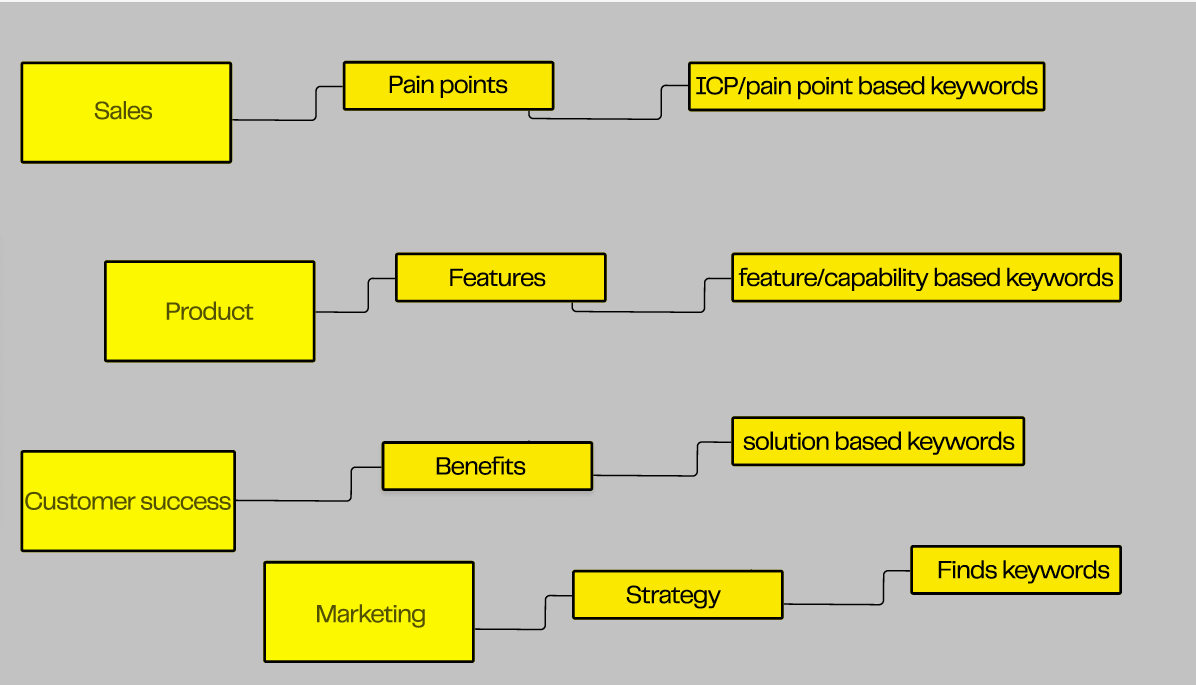
- Sales: ICP and pain point-based keywords
- Product: Feature and capability-based keywords
- Customer success: Benefits and solution-based keywords
- Marketing: Puts it all together into a cohesive strategy
I want you to think of keyword research like a quadrant to ensure nothing slips through the cracks and you cover all the angles.
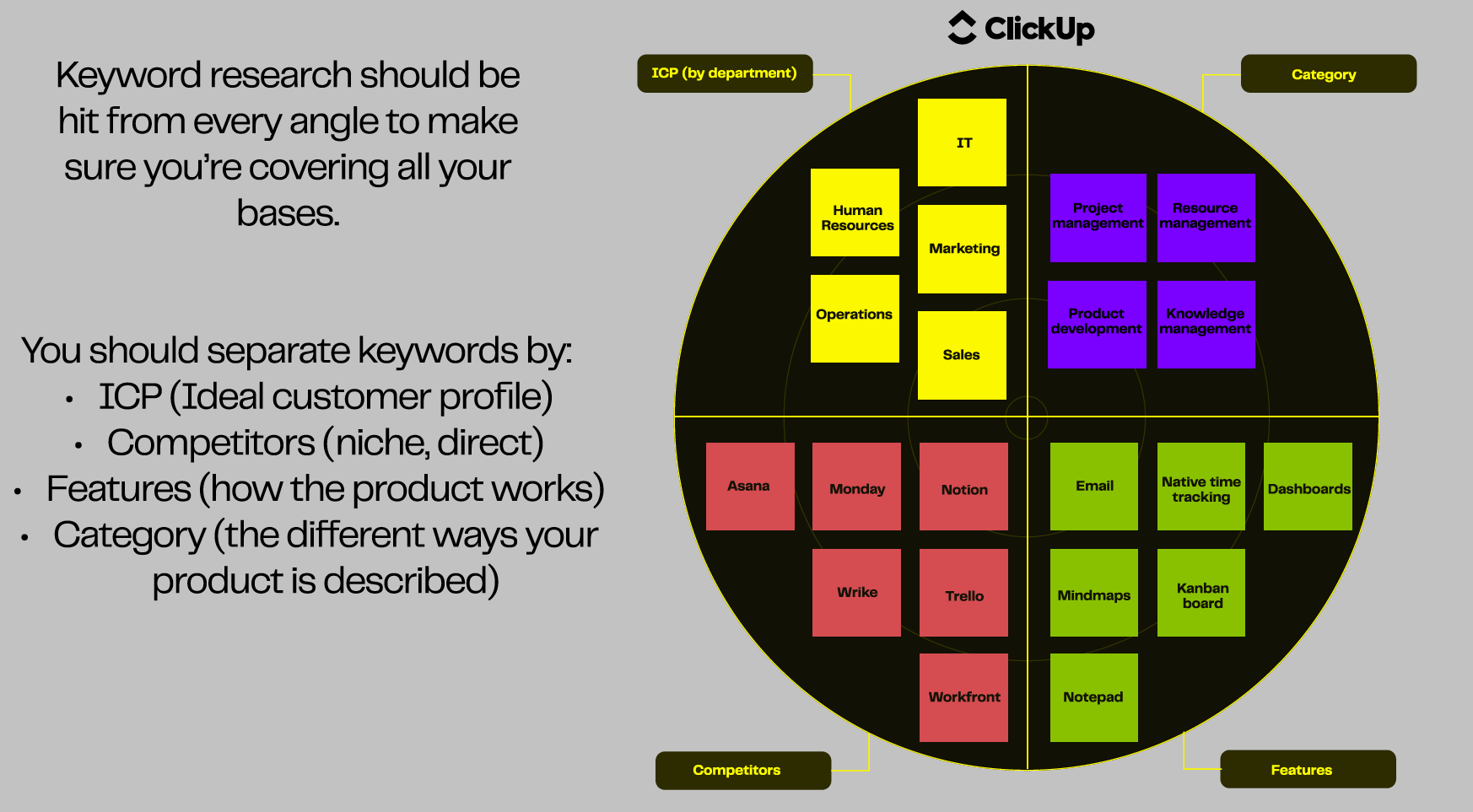
You can find keywords by:
ICP (by department):
This is your ideal customer profile. Here’s the prompt below to gather the data using an LLM:
List specific pain points experienced by this department
Identify their job responsibilities related to your solution
Discover department-specific buying criteria
Research keywords in pattern:
[Department] + [software/solution/tool/platform]
[Department] + [specific pain point] + solution
[Job title] + [productivity/efficiency/management] + tool
Best [solution] for [department]Here’s what the output looks like:
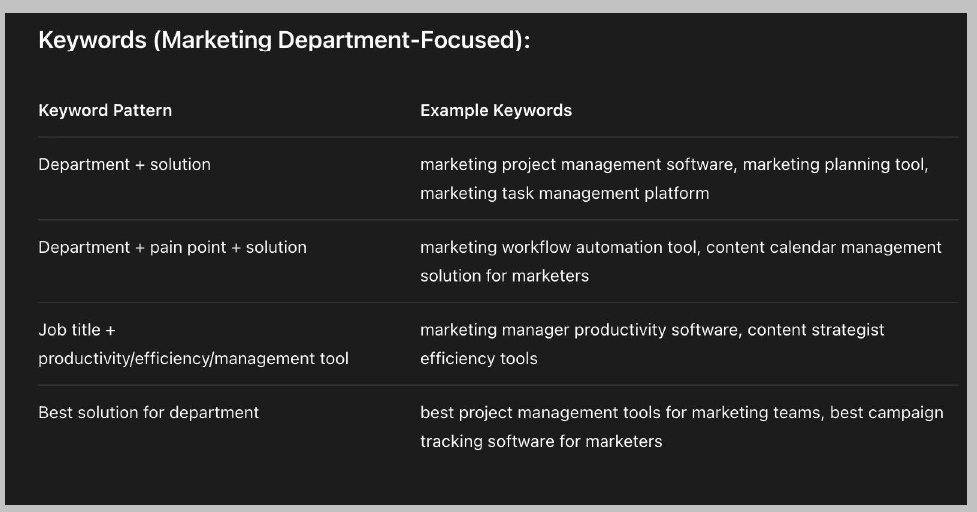
Category
The different ways customers and prospects describe your product or service. Here’s the prompt below to identify terms and industry jargon:
For each product category:
Identify category-specific terminology and industry jargon
Research high-intent keywords in pattern:
Best [category] software/solution/platform
Top [category] tools for [specific use case]
[Category] solution for [specific industry/need]
Enterprise/Small business/Midmarket [category] softwareHere’s what the output looks like

Competitors:
Focus on niche and direct competitors. Here’s the prompt I used to find competitors:
For each major competitor:
Research comparison keywords in pattern:
[Competitor] vs [Client]
[Competitor] alternatives
[Competitor] pricing
[Competitor] vs [Client] for [specific feature/use case]
Switch/migrate from [Competitor] to [Client]
[Competitor] pros and consHere’s what the output looks like
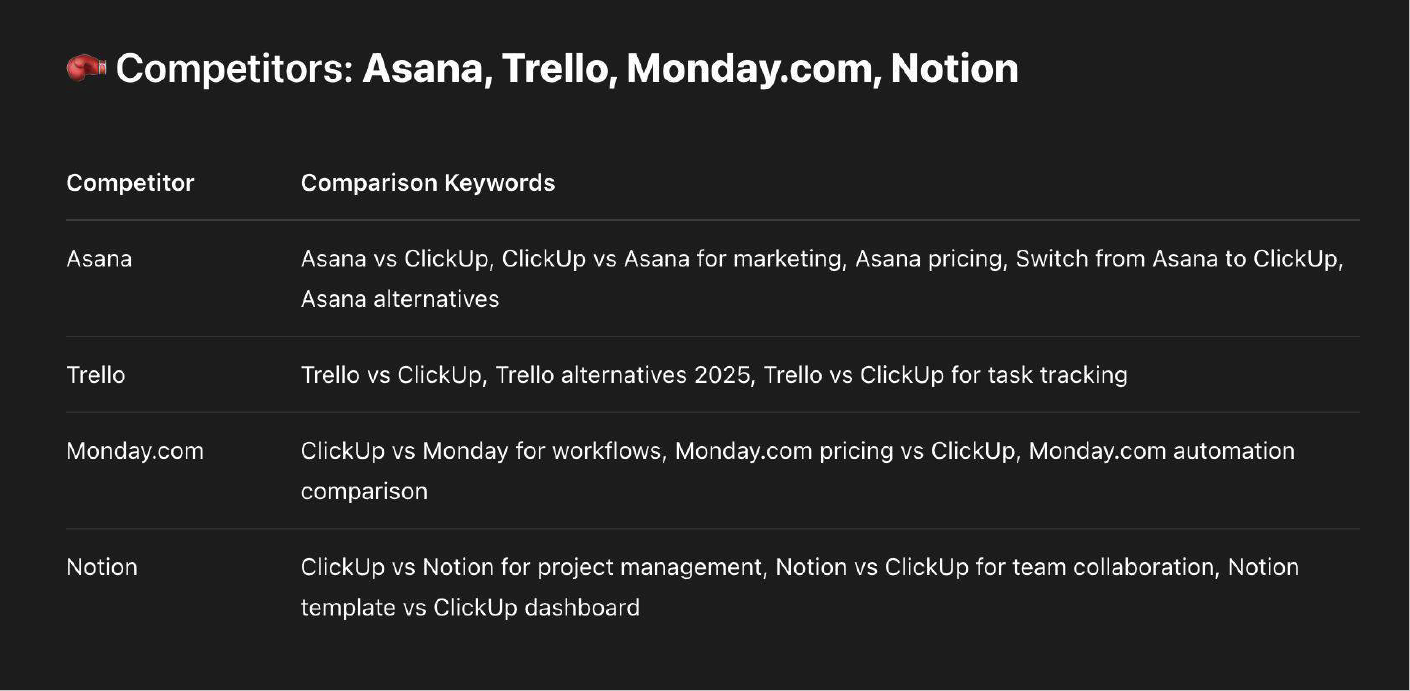
Features
Features describe how your product works. Here’s the prompt I used to flesh out product features:
For each key product feature:
Identify specific pain points each feature solves
Research feature-specific keywords in pattern:
[Specific capability] software/tool
How to [solve specific problem] with [feature]
[Feature] integration with [complementary tools]
Best [product type] with [specific feature]
[Feature] automation/template/dashboardThis is what the output looks like
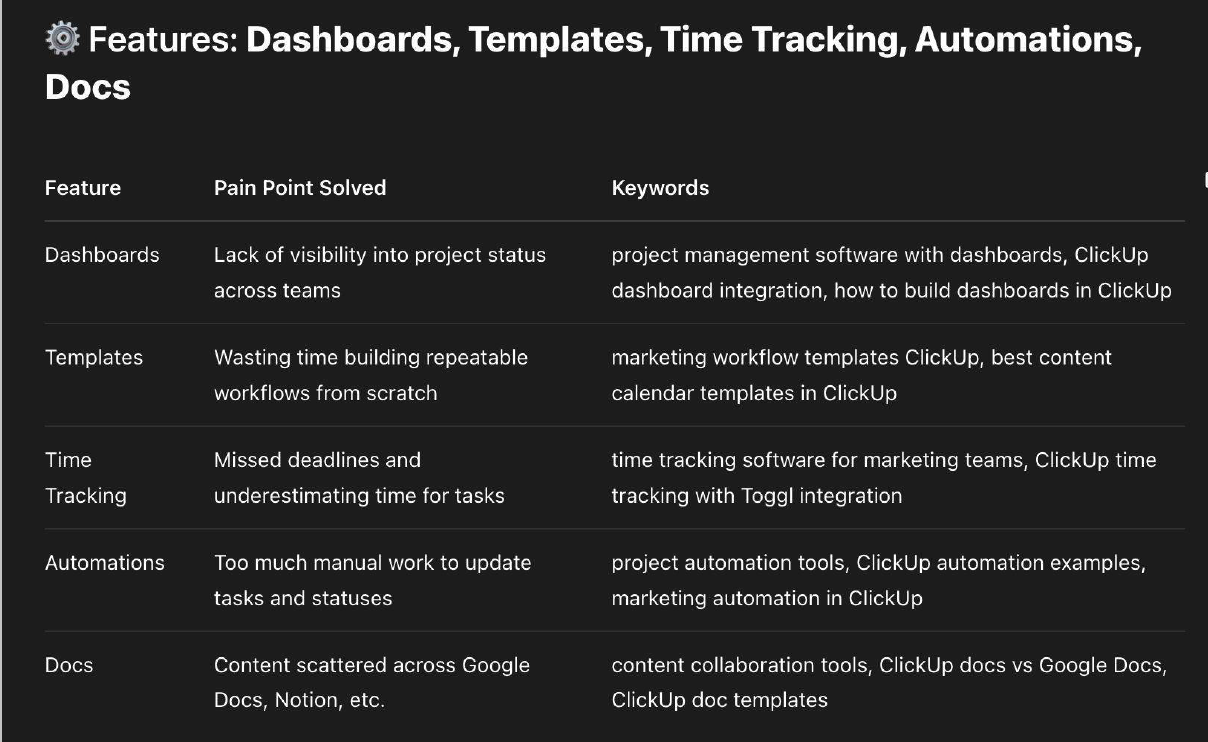
Build your competitor keyword matrix
The easiest way to target BOFU terms from competitors is to apply two patterns:
- Alternative keywords: Framer alternative, Editor X alternative, Semplice alternative
- Versus keywords: Webflow vs Framer, Webflow vs Editor X, Webflow vs Semplice
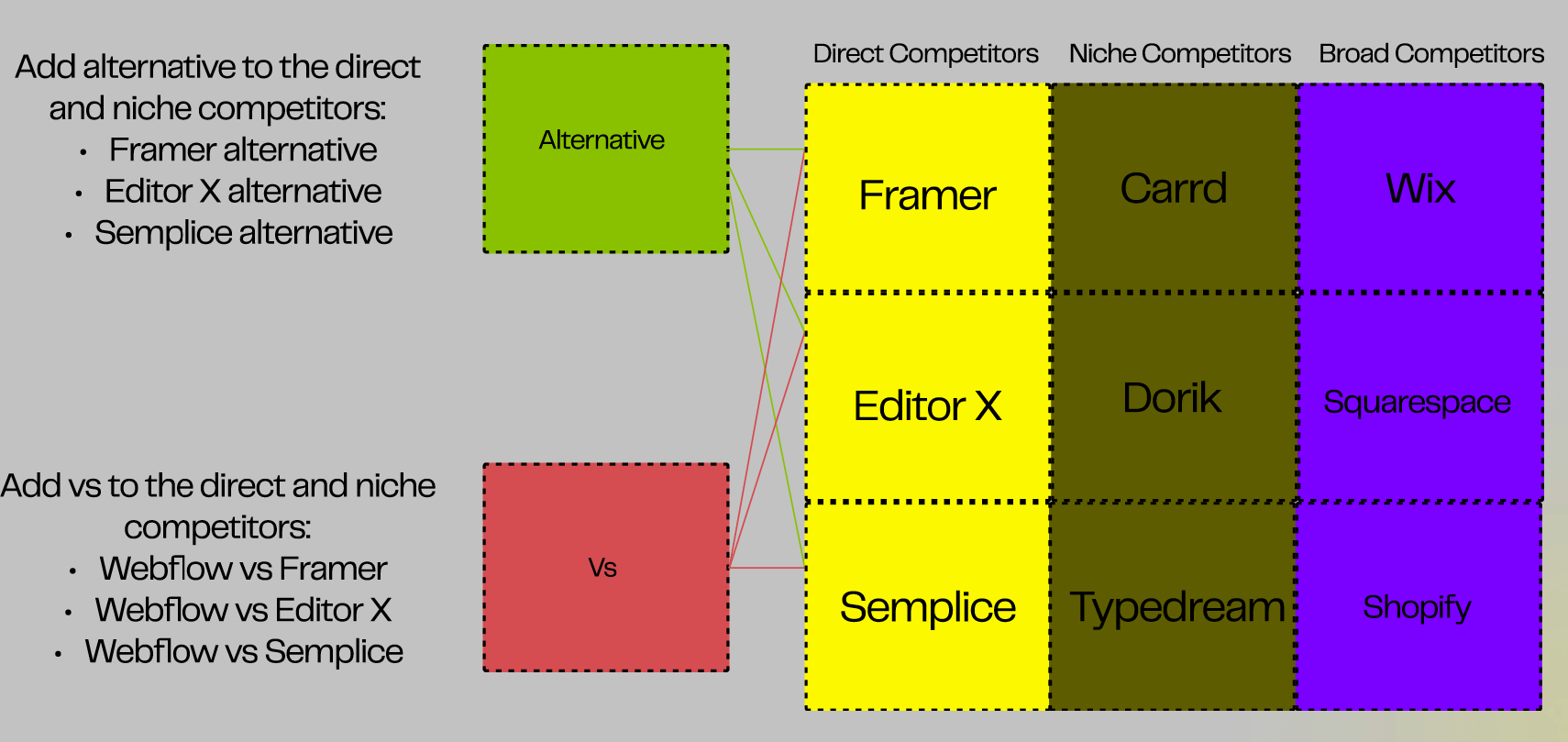
Stick with direct and niche competitors where you can win head-to-head. Avoid broad competitors like Wix or Shopify that serve larger markets and dilute focus.
Find opportunities with the BOFU Alphabet Soup strategy
Alphabet Soup is the fastest free way to find bottom-of-funnel keywords that buyers are typing into search. Type your category into Google with “best [category] software for…” and run through the alphabet to discover new and relevant use cases.
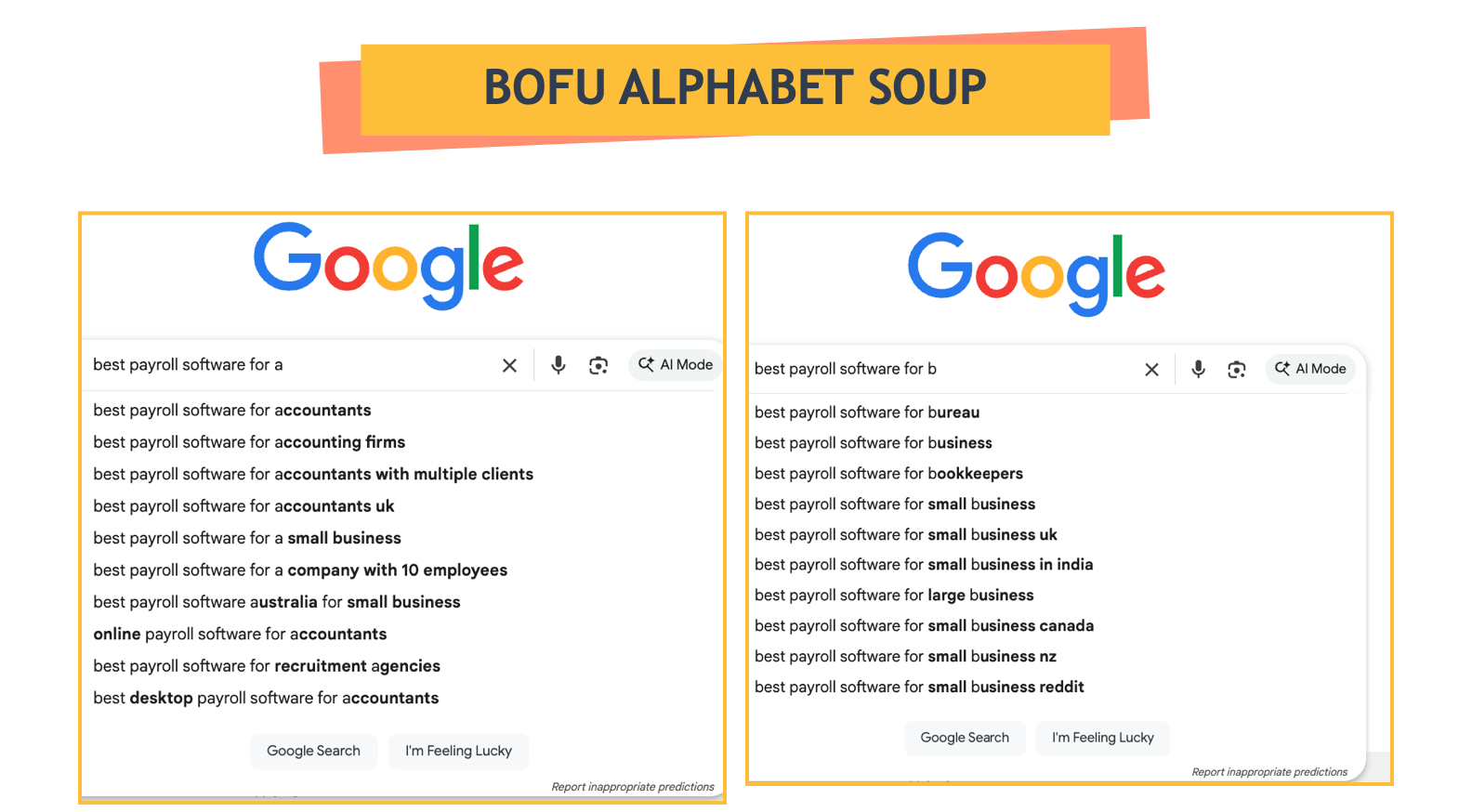
Validate them internally with sales or product to confirm whether you serve those use cases. Then, take your final list of terms and use the bulk keyword analyzer feature in Moz to see which terms have search volume.

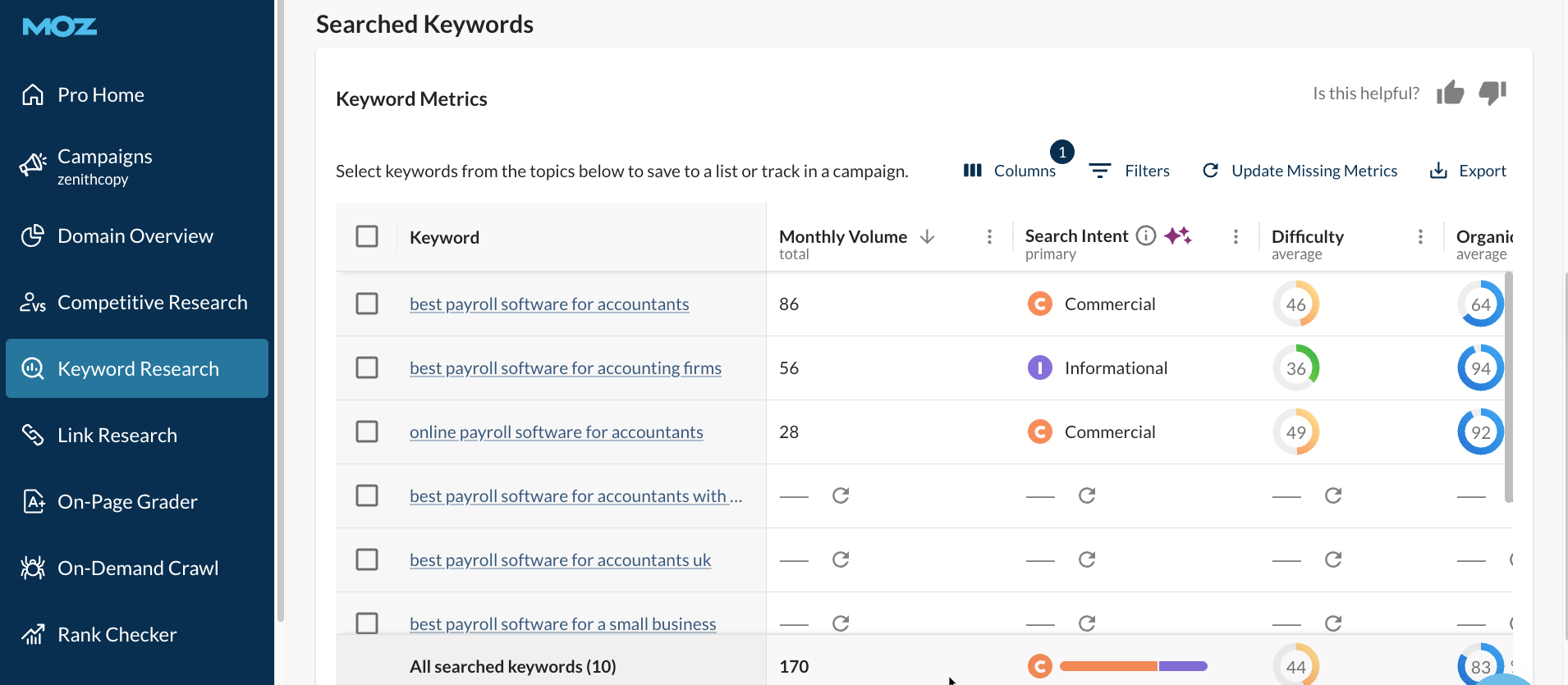
Mine features and use cases
If your product has differentiated features, build keyword sets around them. Example patterns:
- [Feature] software
- How to [solve problem] with [feature]
- Best [category] tool with [feature]
This lets you attract buyers searching for specific capabilities, not just categories.
Match keywords to buying intent
Once you have your list, map each keyword to the funnel stage. Keep your BOFU list focused on commercial and transactional terms that signal decision-making to ensure every article you create is tied to revenue.
Rejoice Ojiaku has a great video on how to map keywords to intent.
4. Produce BOFU content with AI
AI can speed up production, but only if you’re feeding it the right insights. Avoid the mistake of jumping straight to prompts. Instead, use inputs from customer-facing teams to feed your prompts so it moves leads closer to a sale.
Here’s how:
Collect data from internal teams
Each internal team holds a specific piece of the article:
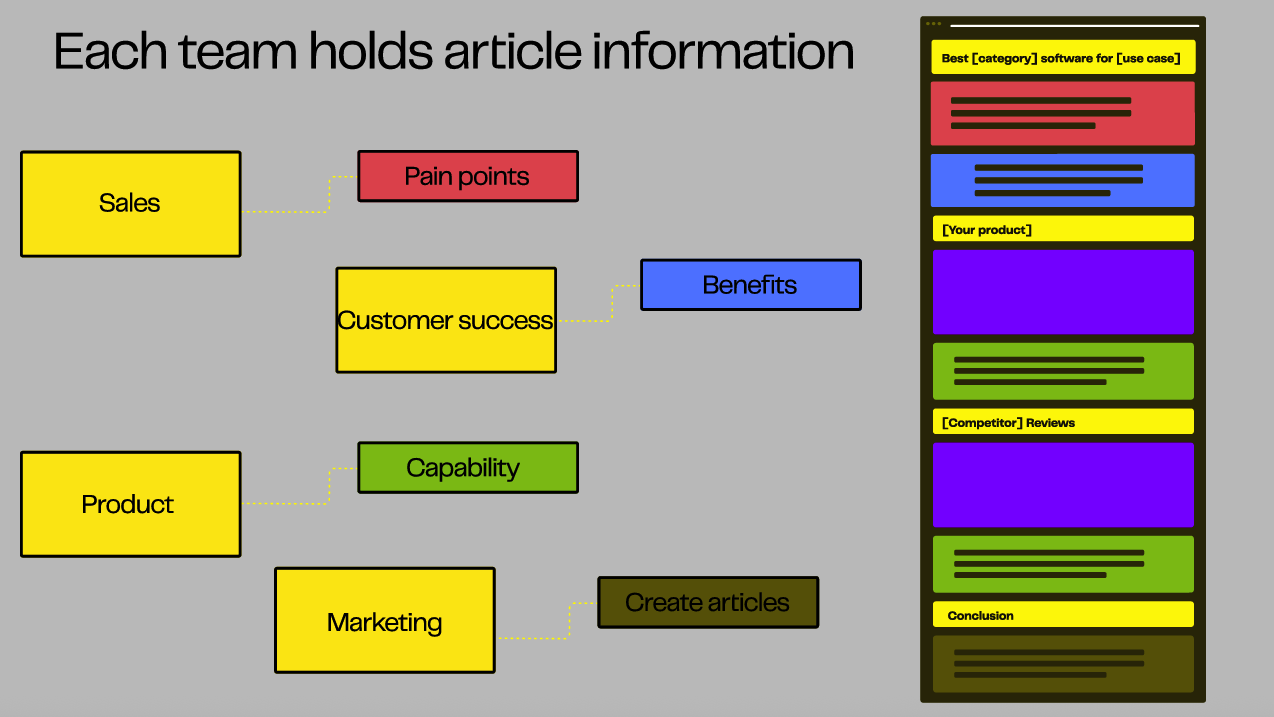
For example, pain points identified from sales and customer success are great for fleshing out product benefits you can use in “best [category] software for [use case]” type of content.
Structure the article section by section
Create a standardized structure for every BOFU asset, whether it's a comparison page, integration post, or case study.
Here’s the format I use:
Start with pain points in the introduction
When writing an introduction, lead with the friction your buyers are feeling. Pull these directly from sales calls or objection-handling docs. The information should be in the first two lines, not buried further down the text.
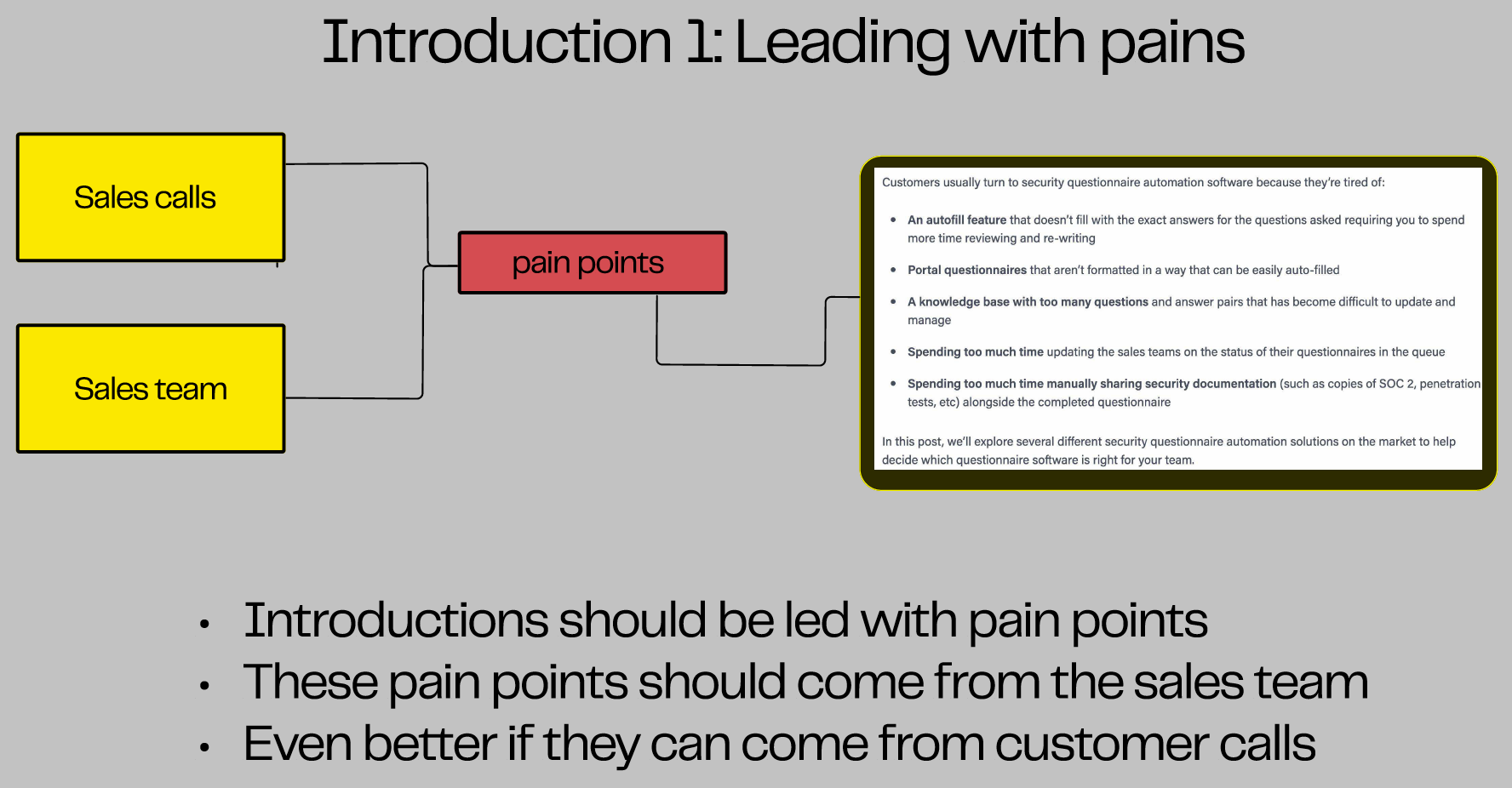
This is the part AI gets wrong most often, and the only way to get it right is by mining internal conversations.
Alternatively, lead with benefits in your introduction
Another option when writing an introduction is to explain how your product solves the problem.
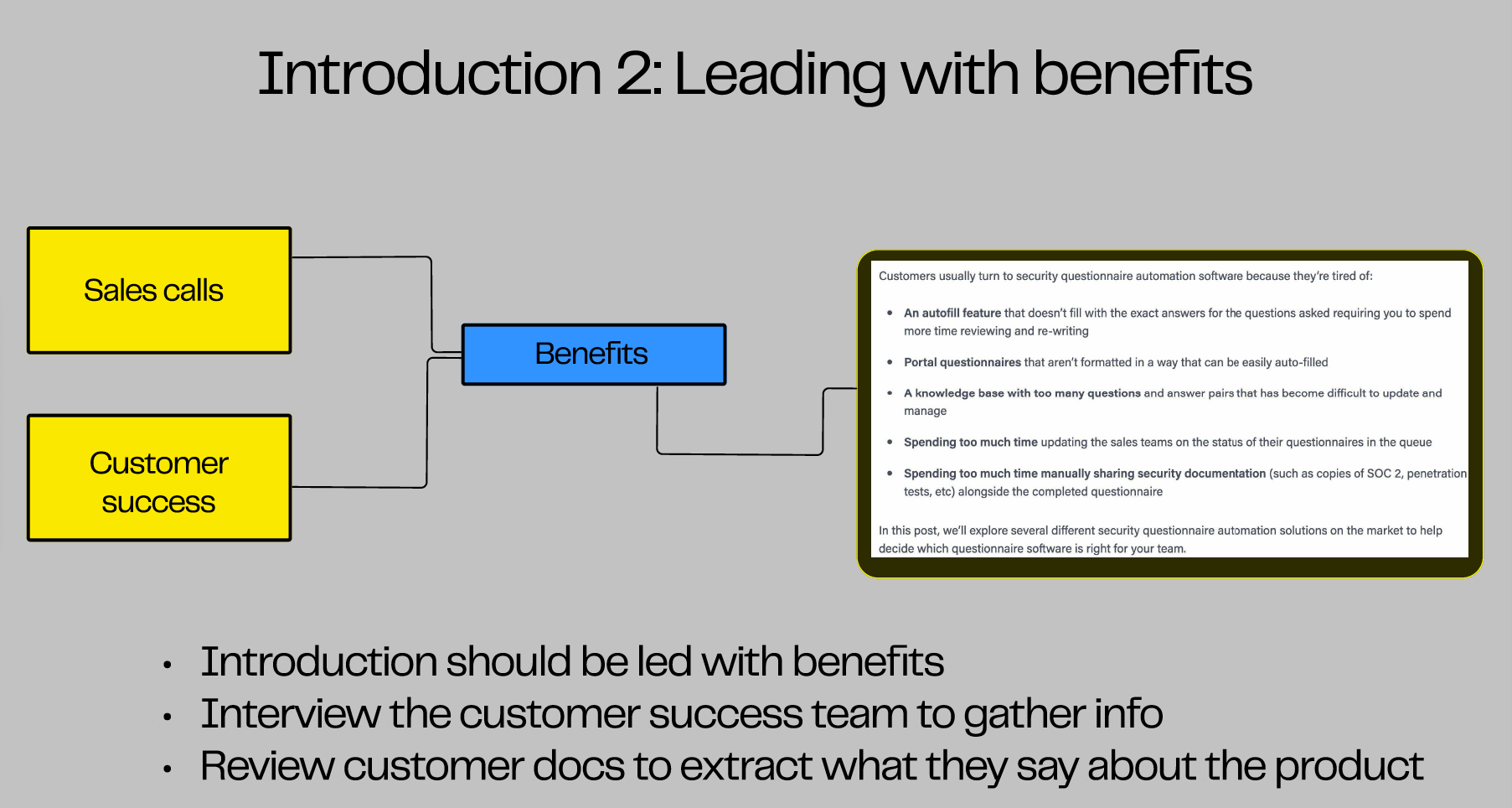
This comes from customer success and includes insights on the benefits they hear when talking to customers.
Show product capabilities
Most content glosses over product features, but they’re very important. This is your chance to go deeper with screenshots and workflows that explain how the tool works in context.
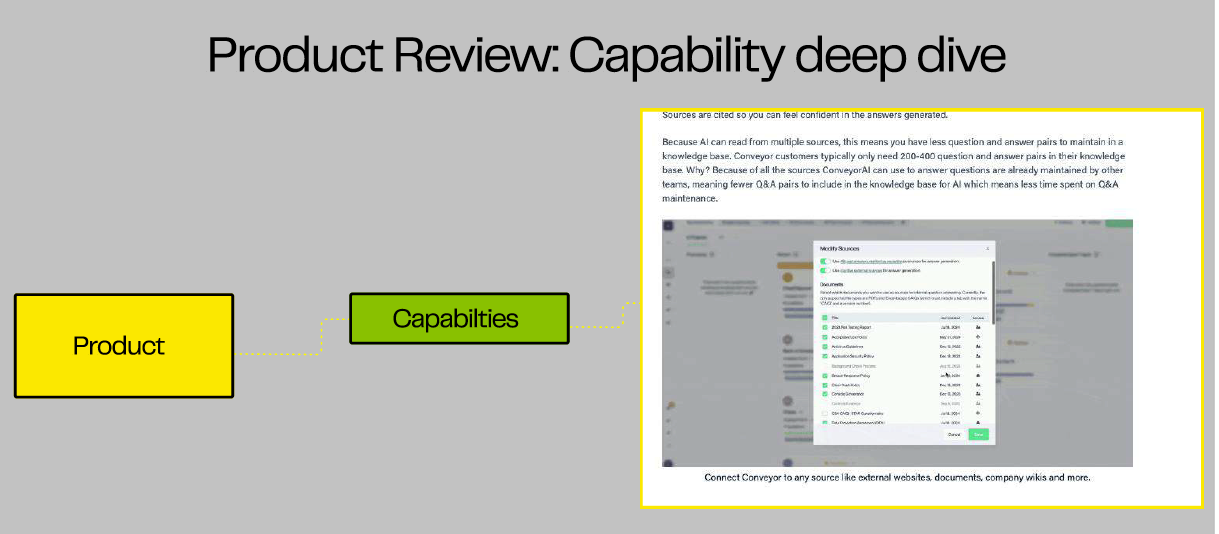
You can get this data from product marketing docs, help center articles, demo videos, or interviews with the product team.
Include competitor breakdowns
Your prospects are already comparing you to others, and you can use this to your advantage. Gather as much public information as you can on competitors. Use public reviews, comparison tables, and competitor FAQs as source material.
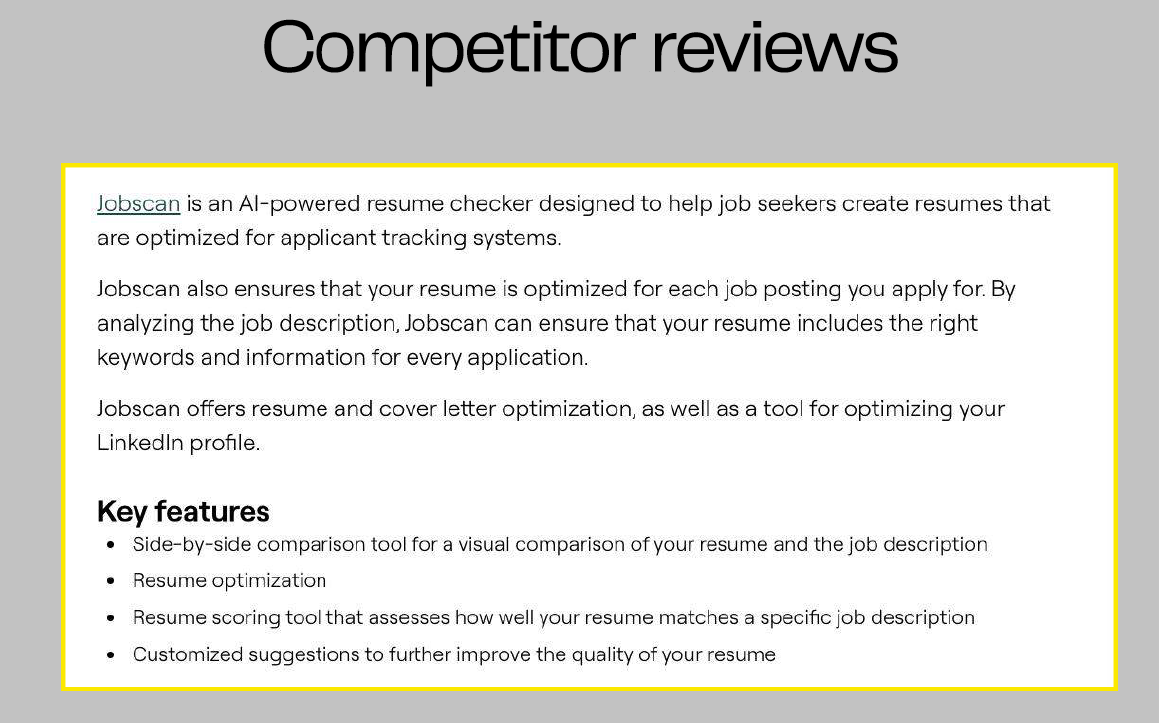
Explain their features and what they do well, and avoid speaking negatively about competitors. Instead, be honest about their gaps and position your product confidently as the better option.
Frame your conclusion as a final call to action
Do not name your conclusion as “conclusion.” Use it as a final call to action to remind the reader of why they need your solution, versus just summarizing it.
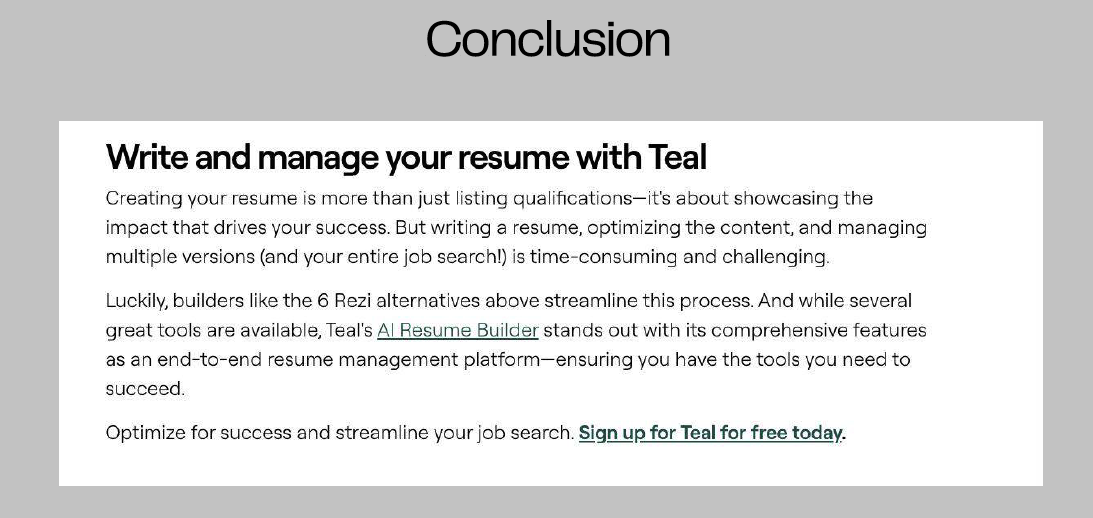
Make your conclusion specific, benefits-driven, and tied to the pain point you opened with.
Combine AI speed with human insight when writing BoFu content
Use AI to:
- Draft the structure based on your chosen template
- Repurpose call transcripts into pain point summaries
- Convert research into blog-ready comparisons
Then, edit with input from sales, product, and CS to ensure accuracy and tone. The result is content that feels tailor-made, because it is.
5. Track inbound leads from content
BOFU content needs to drive pipeline, not just pageviews. Set up your tracking so you can prove impact.
Here’s how I do it:
Use Dealfront, Dreamdata, or PostHog to track lead activity by URL
Dealfront is one of the best tools for tracking inbound leads from BOFU pages.
It lets you:
- See which companies are viewing your content
- Identify URLs driving leads
- Understand the industries and regions those companies represent
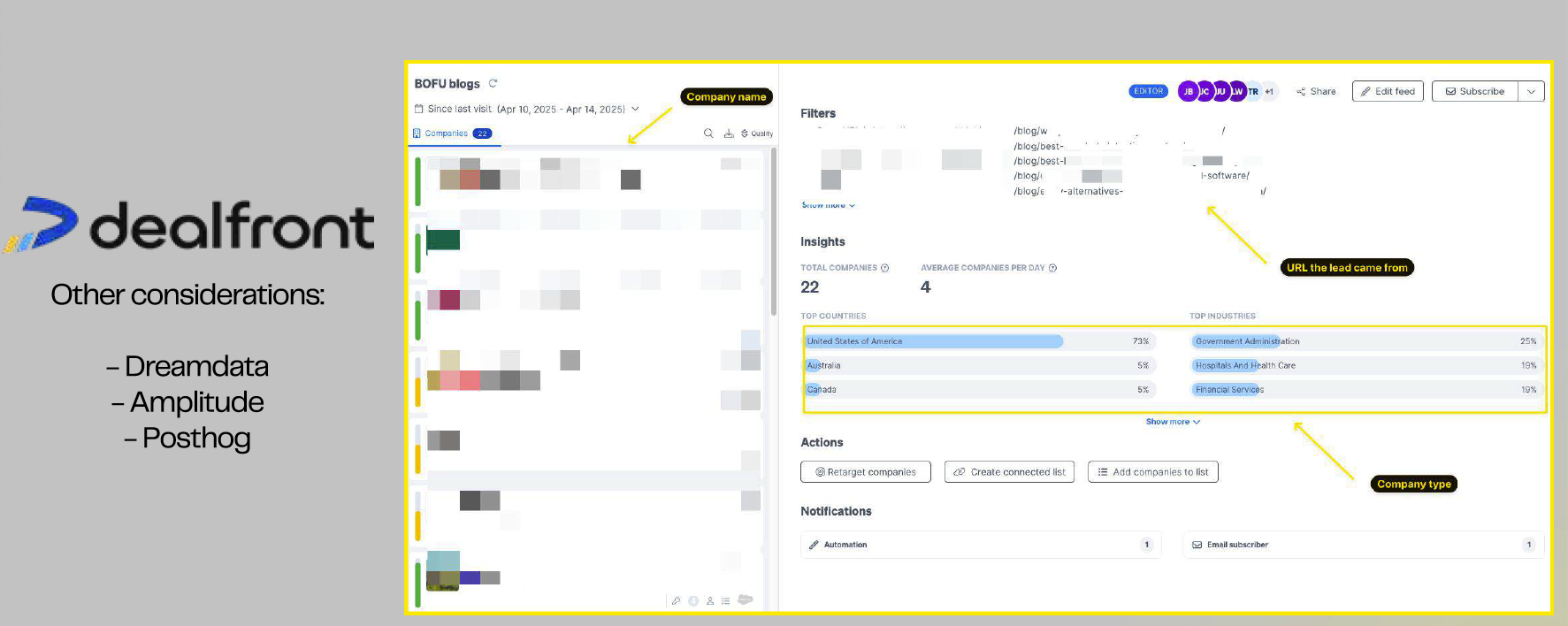
For example, if you’re running a BOFU blog like “Best [category] software” or “[Tool] alternatives,” Dealfront will attribute those visits down to the article level, without waiting for a form fill.
Other tools to consider:
- Dreamdata for full-funnel attribution
- Amplitude for behavioral analytics
- PostHog if you want product-level insight alongside content
Don’t worry about attribution bias, as content often gets under-credited. These tools give you the proof you need to advocate for more investment in BOFU content.
Use Looker Studio dashboards to see which content drives demos
Set up a content-specific dashboard using Looker Studio to visualize what’s driving performance.

You can pull in data from GA4 and map metrics to individual blog URLs.
Use filters to track:
- Page-level views and conversions
- Sessions by traffic source (organic, paid, referral)
- Demo requests and form completions
Here’s a workflow to help you set up your live tracking dashboard. When it’s running, it shows you which BOFU articles are moving users down the funnel.
I’ve got more templates and dashboards for you here that you can customize to your brand to track conversions from BoFu pages right out of the box.
Concluding thoughts: BoFu content only works with cross-functional insight
AI won’t replace your team, but it can improve every part of your content engine. Spend time collecting insights from customer-facing teams and use that to build your prompts. Then, use AI to analyze data and create a repeatable process that drives revenue.
The author's views are entirely their own (excluding the unlikely event of hypnosis) and may not always reflect the views of Moz.





